Assyrian/Chaldean/Syriac vs Belgian Community Comparison
COMPARE
Assyrian/Chaldean/Syriac
Belgian
Social Comparison
Social Comparison
Assyrians/Chaldeans/Syriacs
Belgians
7,301
SOCIAL INDEX
70.5/ 100
SOCIAL RATING
124th/ 347
SOCIAL RANK
7,372
SOCIAL INDEX
71.2/ 100
SOCIAL RATING
120th/ 347
SOCIAL RANK
Belgian Integration in Assyrian/Chaldean/Syriac Communities
The statistical analysis conducted on geographies consisting of 100,753,660 people shows a poor positive correlation between the proportion of Belgians within Assyrian/Chaldean/Syriac communities in the United States with a correlation coefficient (R) of 0.103. On average, for every 1% (one percent) increase in Assyrians/Chaldeans/Syriacs within a typical geography, there is an increase of 0.009% in Belgians. To illustrate, in a geography comprising of 100,000 individuals, a rise of 1,000 Assyrians/Chaldeans/Syriacs corresponds to an increase of 9.1 Belgians.
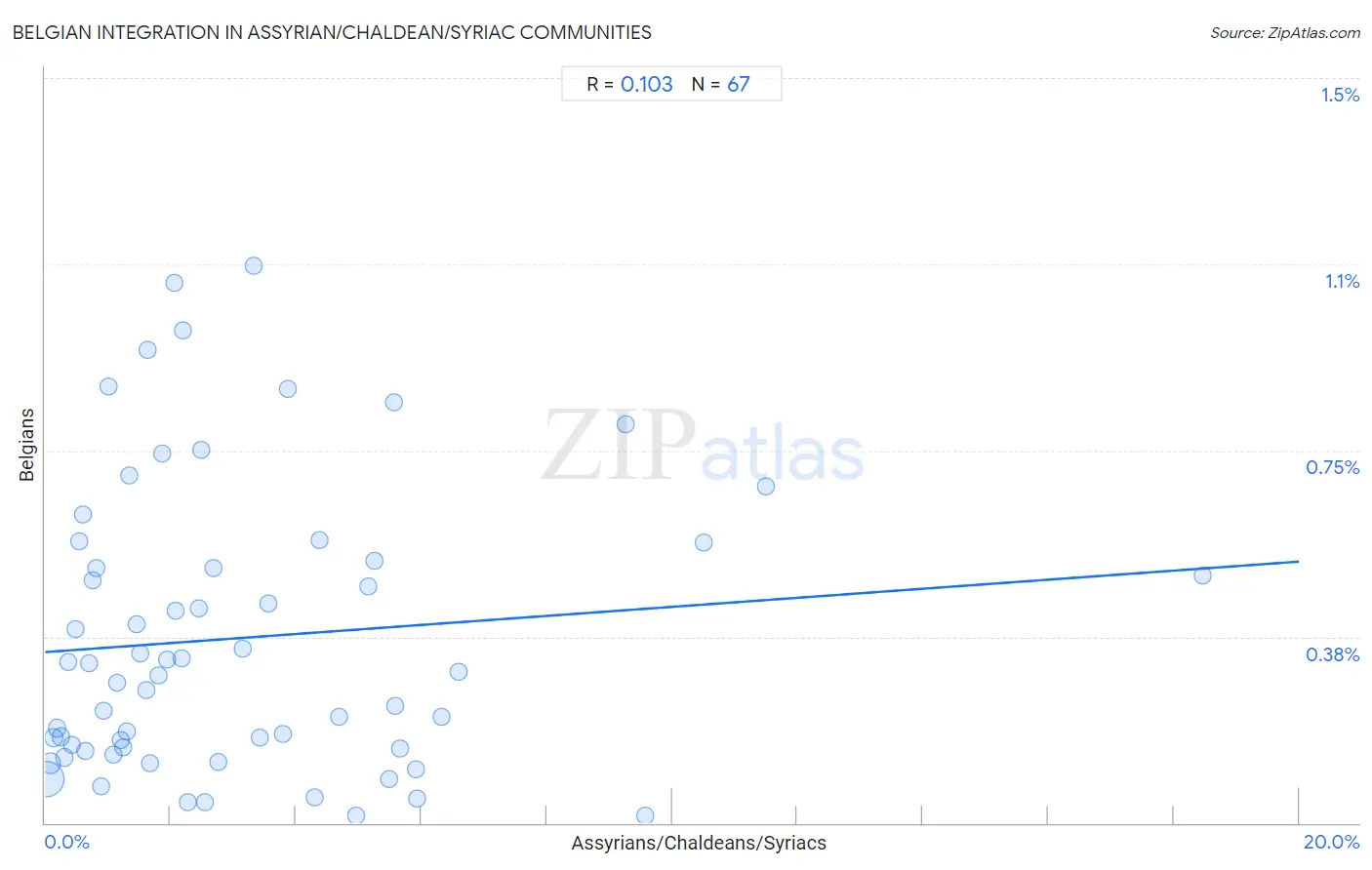
Assyrian/Chaldean/Syriac vs Belgian Income
When considering income, the most significant differences between Assyrian/Chaldean/Syriac and Belgian communities in the United States are seen in householder income under 25 years ($65,329 compared to $50,113, a difference of 30.4%), householder income ages 45 - 64 years ($110,201 compared to $100,060, a difference of 10.1%), and median household income ($91,991 compared to $84,008, a difference of 9.5%). Conversely, both communities are more comparable in terms of median female earnings ($39,159 compared to $38,382, a difference of 2.0%), per capita income ($45,195 compared to $43,951, a difference of 2.8%), and median earnings ($48,304 compared to $46,375, a difference of 4.2%).

| Income Metric | Assyrian/Chaldean/Syriac | Belgian |
| Per Capita Income | Excellent $45,195 | Average $43,951 |
| Median Family Income | Exceptional $109,622 | Average $102,788 |
| Median Household Income | Exceptional $91,991 | Fair $84,008 |
| Median Earnings | Exceptional $48,304 | Average $46,375 |
| Median Male Earnings | Exceptional $58,437 | Good $55,361 |
| Median Female Earnings | Fair $39,159 | Tragic $38,382 |
| Householder Age | Under 25 years | Exceptional $65,329 | Tragic $50,113 |
| Householder Age | 25 - 44 years | Exceptional $101,936 | Average $94,262 |
| Householder Age | 45 - 64 years | Exceptional $110,201 | Average $100,060 |
| Householder Age | Over 65 years | Exceptional $64,108 | Fair $59,915 |
| Wage/Income Gap | Tragic 31.0% | Tragic 28.8% |
Assyrian/Chaldean/Syriac vs Belgian Poverty
When considering poverty, the most significant differences between Assyrian/Chaldean/Syriac and Belgian communities in the United States are seen in female poverty among 18-24 year olds (13.7% compared to 19.9%, a difference of 45.2%), single father poverty (11.7% compared to 16.8%, a difference of 43.3%), and single male poverty (9.8% compared to 13.5%, a difference of 38.7%). Conversely, both communities are more comparable in terms of seniors poverty over the age of 65 (9.6% compared to 9.5%, a difference of 0.76%), seniors poverty over the age of 75 (10.7% compared to 11.0%, a difference of 3.0%), and receiving food stamps (10.6% compared to 10.2%, a difference of 3.9%).
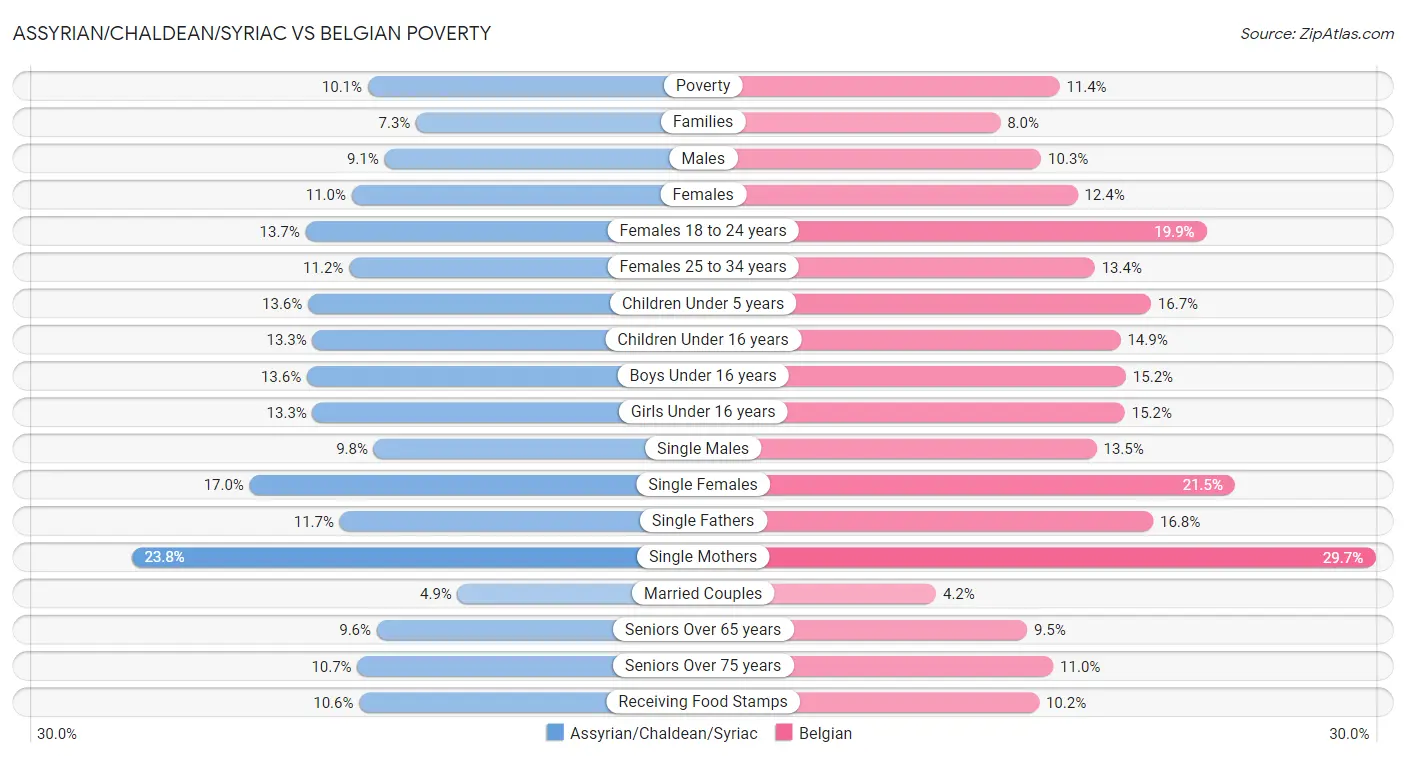
| Poverty Metric | Assyrian/Chaldean/Syriac | Belgian |
| Poverty | Exceptional 10.1% | Exceptional 11.4% |
| Families | Exceptional 7.3% | Exceptional 8.0% |
| Males | Exceptional 9.1% | Exceptional 10.3% |
| Females | Exceptional 11.0% | Exceptional 12.4% |
| Females 18 to 24 years | Exceptional 13.7% | Good 19.9% |
| Females 25 to 34 years | Exceptional 11.2% | Average 13.4% |
| Children Under 5 years | Exceptional 13.6% | Good 16.7% |
| Children Under 16 years | Exceptional 13.3% | Exceptional 14.9% |
| Boys Under 16 years | Exceptional 13.6% | Exceptional 15.2% |
| Girls Under 16 years | Exceptional 13.3% | Exceptional 15.2% |
| Single Males | Exceptional 9.8% | Tragic 13.5% |
| Single Females | Exceptional 17.0% | Poor 21.5% |
| Single Fathers | Exceptional 11.7% | Tragic 16.8% |
| Single Mothers | Exceptional 23.8% | Poor 29.7% |
| Married Couples | Excellent 4.9% | Exceptional 4.2% |
| Seniors Over 65 years | Exceptional 9.6% | Exceptional 9.5% |
| Seniors Over 75 years | Exceptional 10.7% | Exceptional 11.0% |
| Receiving Food Stamps | Exceptional 10.6% | Exceptional 10.2% |
Assyrian/Chaldean/Syriac vs Belgian Unemployment
When considering unemployment, the most significant differences between Assyrian/Chaldean/Syriac and Belgian communities in the United States are seen in unemployment among women with children ages 6 to 17 years (7.2% compared to 9.2%, a difference of 28.1%), female unemployment (5.6% compared to 4.6%, a difference of 22.7%), and unemployment among women with children under 6 years (6.5% compared to 7.6%, a difference of 17.4%). Conversely, both communities are more comparable in terms of unemployment among ages 55 to 59 years (4.5% compared to 4.5%, a difference of 0.37%), unemployment among ages 65 to 74 years (5.1% compared to 5.0%, a difference of 1.0%), and unemployment among ages 30 to 34 years (5.1% compared to 5.1%, a difference of 1.2%).
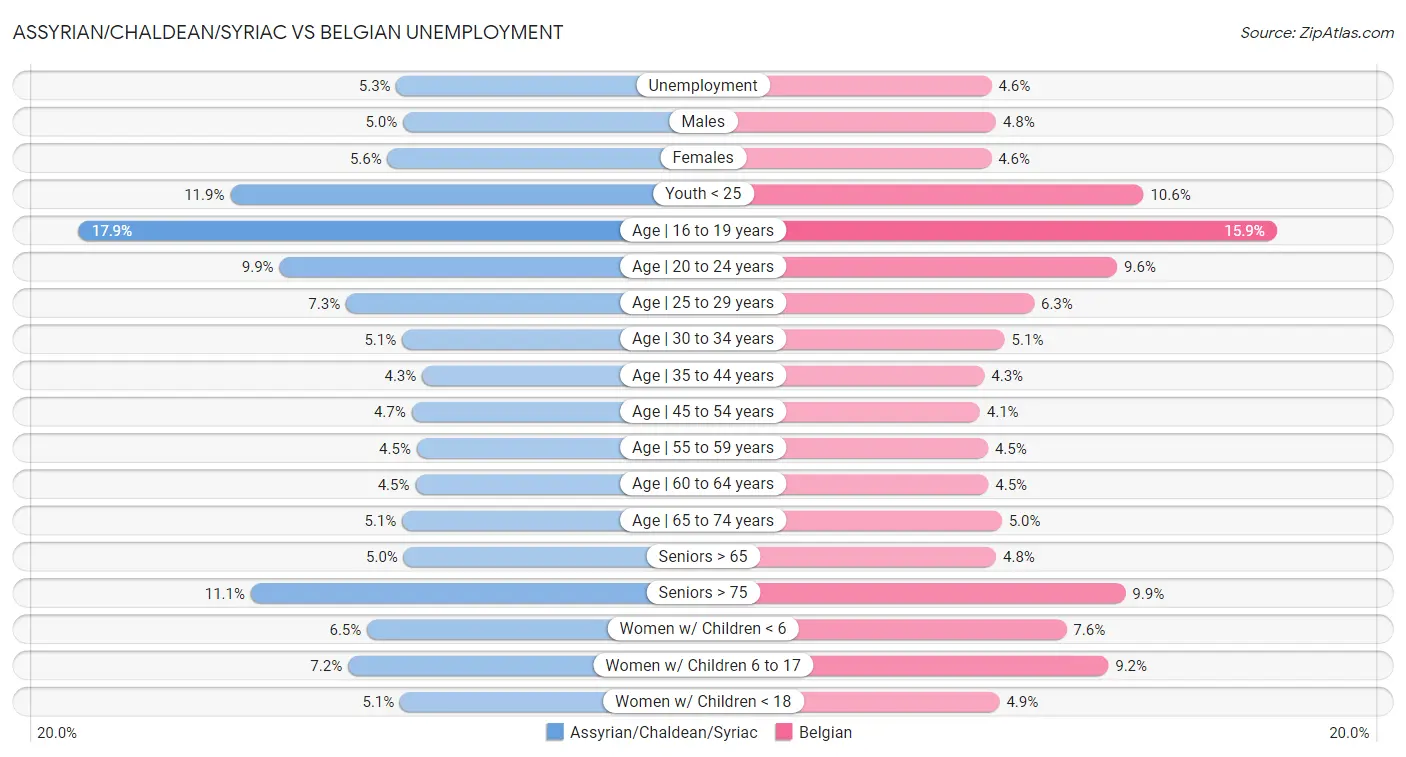
| Unemployment Metric | Assyrian/Chaldean/Syriac | Belgian |
| Unemployment | Fair 5.3% | Exceptional 4.6% |
| Males | Exceptional 5.0% | Exceptional 4.8% |
| Females | Tragic 5.6% | Exceptional 4.6% |
| Youth < 25 | Tragic 11.9% | Exceptional 10.6% |
| Age | 16 to 19 years | Fair 17.9% | Exceptional 15.9% |
| Age | 20 to 24 years | Exceptional 9.9% | Exceptional 9.6% |
| Age | 25 to 29 years | Tragic 7.3% | Exceptional 6.3% |
| Age | 30 to 34 years | Exceptional 5.1% | Exceptional 5.1% |
| Age | 35 to 44 years | Exceptional 4.3% | Exceptional 4.3% |
| Age | 45 to 54 years | Tragic 4.7% | Exceptional 4.1% |
| Age | 55 to 59 years | Exceptional 4.5% | Exceptional 4.5% |
| Age | 60 to 64 years | Exceptional 4.5% | Exceptional 4.5% |
| Age | 65 to 74 years | Exceptional 5.1% | Exceptional 5.0% |
| Seniors > 65 | Exceptional 5.0% | Exceptional 4.8% |
| Seniors > 75 | Tragic 11.1% | Tragic 9.9% |
| Women w/ Children < 6 | Exceptional 6.5% | Good 7.6% |
| Women w/ Children 6 to 17 | Exceptional 7.2% | Tragic 9.2% |
| Women w/ Children < 18 | Exceptional 5.1% | Exceptional 4.9% |
Assyrian/Chaldean/Syriac vs Belgian Labor Participation
When considering labor participation, the most significant differences between Assyrian/Chaldean/Syriac and Belgian communities in the United States are seen in in labor force | age 16-19 (38.3% compared to 43.4%, a difference of 13.2%), in labor force | age 20-24 (75.9% compared to 77.8%, a difference of 2.5%), and in labor force | age 30-34 (83.2% compared to 85.2%, a difference of 2.4%). Conversely, both communities are more comparable in terms of in labor force | age 45-54 (83.2% compared to 83.4%, a difference of 0.20%), in labor force | age 20-64 (79.4% compared to 79.9%, a difference of 0.53%), and in labor force | age 35-44 (84.0% compared to 84.9%, a difference of 1.0%).

| Labor Participation Metric | Assyrian/Chaldean/Syriac | Belgian |
| In Labor Force | Age > 16 | Tragic 64.0% | Poor 64.7% |
| In Labor Force | Age 20-64 | Fair 79.4% | Excellent 79.9% |
| In Labor Force | Age 16-19 | Exceptional 38.3% | Exceptional 43.4% |
| In Labor Force | Age 20-24 | Exceptional 75.9% | Exceptional 77.8% |
| In Labor Force | Age 25-29 | Average 84.7% | Exceptional 85.5% |
| In Labor Force | Age 30-34 | Tragic 83.2% | Exceptional 85.2% |
| In Labor Force | Age 35-44 | Tragic 84.0% | Exceptional 84.9% |
| In Labor Force | Age 45-54 | Exceptional 83.2% | Exceptional 83.4% |
Assyrian/Chaldean/Syriac vs Belgian Family Structure
When considering family structure, the most significant differences between Assyrian/Chaldean/Syriac and Belgian communities in the United States are seen in births to unmarried women (22.0% compared to 31.6%, a difference of 43.8%), single mother households (4.8% compared to 5.8%, a difference of 21.6%), and single father households (2.0% compared to 2.3%, a difference of 19.9%). Conversely, both communities are more comparable in terms of currently married (50.8% compared to 48.7%, a difference of 4.2%), average family size (3.24 compared to 3.11, a difference of 4.4%), and family households with children (28.1% compared to 26.9%, a difference of 4.6%).

| Family Structure Metric | Assyrian/Chaldean/Syriac | Belgian |
| Family Households | Exceptional 68.2% | Tragic 63.8% |
| Family Households with Children | Exceptional 28.1% | Tragic 26.9% |
| Married-couple Households | Exceptional 51.8% | Exceptional 48.0% |
| Average Family Size | Good 3.24 | Tragic 3.11 |
| Single Father Households | Exceptional 2.0% | Average 2.3% |
| Single Mother Households | Exceptional 4.8% | Exceptional 5.8% |
| Currently Married | Exceptional 50.8% | Exceptional 48.7% |
| Divorced or Separated | Exceptional 10.6% | Tragic 12.3% |
| Births to Unmarried Women | Exceptional 22.0% | Average 31.6% |
Assyrian/Chaldean/Syriac vs Belgian Vehicle Availability
When considering vehicle availability, the most significant differences between Assyrian/Chaldean/Syriac and Belgian communities in the United States are seen in no vehicles in household (7.0% compared to 8.0%, a difference of 14.4%), 4 or more vehicles in household (7.2% compared to 6.8%, a difference of 5.7%), and 3 or more vehicles in household (21.7% compared to 21.2%, a difference of 2.6%). Conversely, both communities are more comparable in terms of 1 or more vehicles in household (93.0% compared to 92.1%, a difference of 0.99%), 2 or more vehicles in household (60.5% compared to 59.3%, a difference of 2.2%), and 3 or more vehicles in household (21.7% compared to 21.2%, a difference of 2.6%).

| Vehicle Availability Metric | Assyrian/Chaldean/Syriac | Belgian |
| No Vehicles Available | Exceptional 7.0% | Exceptional 8.0% |
| 1+ Vehicles Available | Exceptional 93.0% | Exceptional 92.1% |
| 2+ Vehicles Available | Exceptional 60.5% | Exceptional 59.3% |
| 3+ Vehicles Available | Exceptional 21.7% | Exceptional 21.2% |
| 4+ Vehicles Available | Exceptional 7.2% | Exceptional 6.8% |
Assyrian/Chaldean/Syriac vs Belgian Education Level
When considering education level, the most significant differences between Assyrian/Chaldean/Syriac and Belgian communities in the United States are seen in no schooling completed (2.5% compared to 1.6%, a difference of 55.6%), doctorate degree (1.7% compared to 1.8%, a difference of 11.3%), and master's degree (15.8% compared to 14.5%, a difference of 9.3%). Conversely, both communities are more comparable in terms of ged/equivalency (87.0% compared to 87.7%, a difference of 0.77%), nursery school (97.6% compared to 98.5%, a difference of 0.96%), and kindergarten (97.5% compared to 98.5%, a difference of 0.96%).
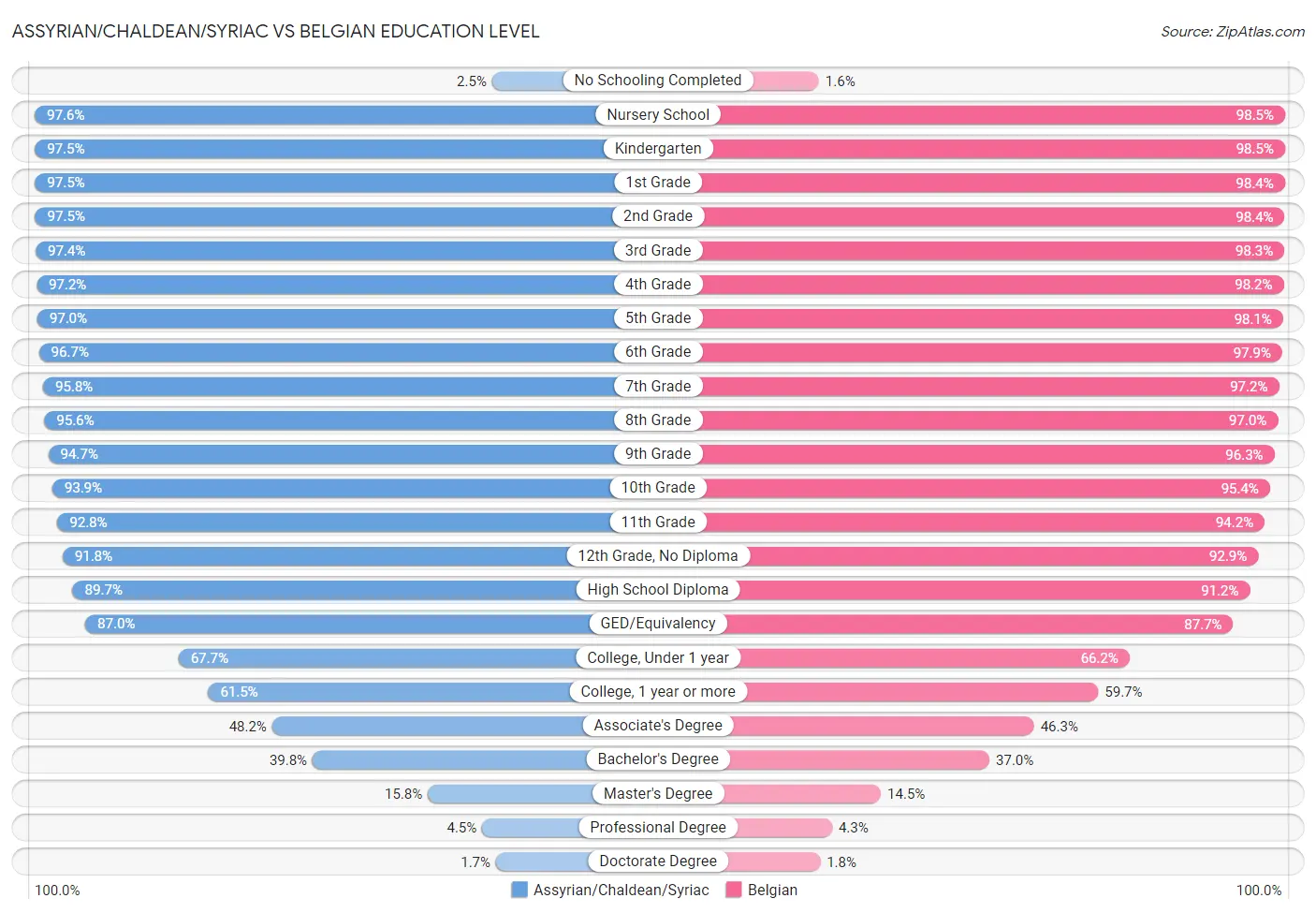
| Education Level Metric | Assyrian/Chaldean/Syriac | Belgian |
| No Schooling Completed | Tragic 2.5% | Exceptional 1.6% |
| Nursery School | Tragic 97.6% | Exceptional 98.5% |
| Kindergarten | Tragic 97.5% | Exceptional 98.5% |
| 1st Grade | Tragic 97.5% | Exceptional 98.4% |
| 2nd Grade | Tragic 97.5% | Exceptional 98.4% |
| 3rd Grade | Tragic 97.4% | Exceptional 98.3% |
| 4th Grade | Tragic 97.2% | Exceptional 98.2% |
| 5th Grade | Tragic 97.0% | Exceptional 98.1% |
| 6th Grade | Tragic 96.7% | Exceptional 97.9% |
| 7th Grade | Fair 95.8% | Exceptional 97.2% |
| 8th Grade | Fair 95.6% | Exceptional 97.0% |
| 9th Grade | Fair 94.7% | Exceptional 96.3% |
| 10th Grade | Good 93.9% | Exceptional 95.4% |
| 11th Grade | Excellent 92.8% | Exceptional 94.2% |
| 12th Grade, No Diploma | Excellent 91.8% | Exceptional 92.9% |
| High School Diploma | Excellent 89.7% | Exceptional 91.2% |
| GED/Equivalency | Exceptional 87.0% | Exceptional 87.7% |
| College, Under 1 year | Exceptional 67.7% | Good 66.2% |
| College, 1 year or more | Exceptional 61.5% | Average 59.7% |
| Associate's Degree | Excellent 48.2% | Average 46.3% |
| Bachelor's Degree | Excellent 39.8% | Fair 37.0% |
| Master's Degree | Excellent 15.8% | Fair 14.5% |
| Professional Degree | Good 4.5% | Fair 4.3% |
| Doctorate Degree | Tragic 1.7% | Average 1.8% |
Assyrian/Chaldean/Syriac vs Belgian Disability
When considering disability, the most significant differences between Assyrian/Chaldean/Syriac and Belgian communities in the United States are seen in disability age under 5 (1.1% compared to 1.4%, a difference of 31.6%), disability age 18 to 34 (6.1% compared to 7.4%, a difference of 21.2%), and self-care disability (2.8% compared to 2.4%, a difference of 18.7%). Conversely, both communities are more comparable in terms of female disability (12.5% compared to 12.5%, a difference of 0.21%), disability age 65 to 74 (23.4% compared to 22.7%, a difference of 2.9%), and disability (11.9% compared to 12.3%, a difference of 3.1%).
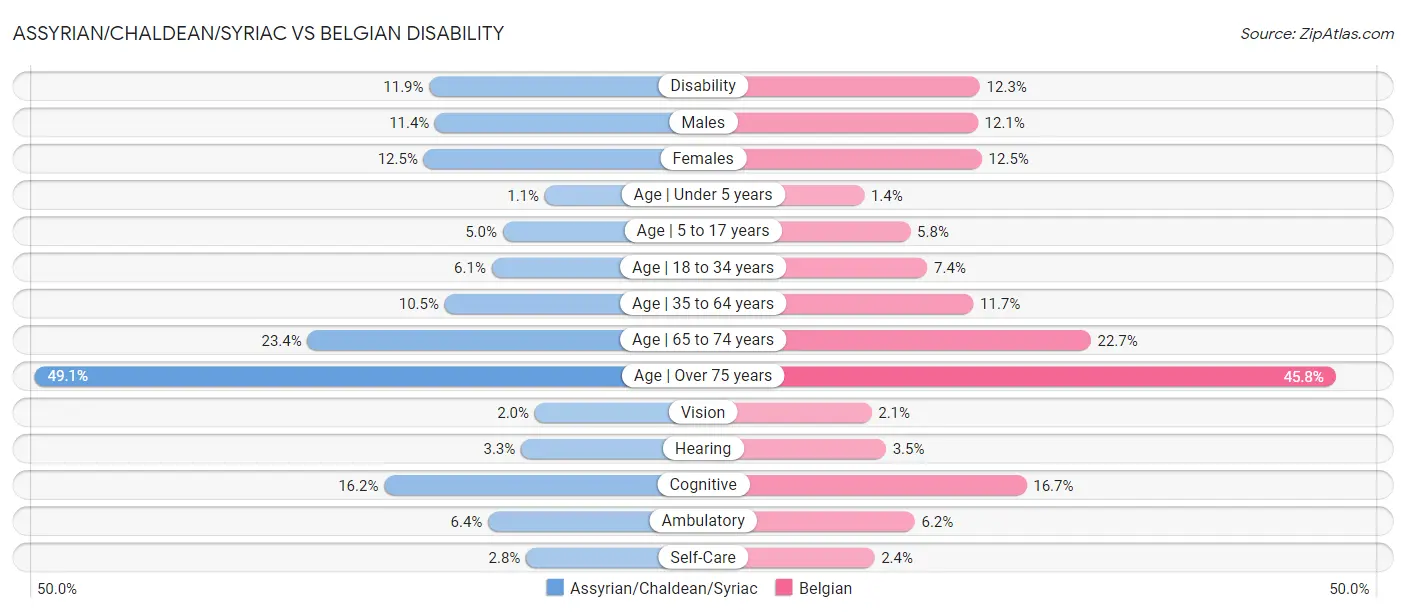
| Disability Metric | Assyrian/Chaldean/Syriac | Belgian |
| Disability | Poor 11.9% | Tragic 12.3% |
| Males | Fair 11.4% | Tragic 12.1% |
| Females | Tragic 12.5% | Tragic 12.5% |
| Age | Under 5 years | Exceptional 1.1% | Tragic 1.4% |
| Age | 5 to 17 years | Exceptional 5.0% | Tragic 5.8% |
| Age | 18 to 34 years | Exceptional 6.1% | Tragic 7.4% |
| Age | 35 to 64 years | Exceptional 10.5% | Poor 11.7% |
| Age | 65 to 74 years | Average 23.4% | Excellent 22.7% |
| Age | Over 75 years | Tragic 49.1% | Exceptional 45.8% |
| Vision | Exceptional 2.0% | Good 2.1% |
| Hearing | Tragic 3.3% | Tragic 3.5% |
| Cognitive | Exceptional 16.2% | Exceptional 16.7% |
| Ambulatory | Tragic 6.4% | Fair 6.2% |
| Self-Care | Tragic 2.8% | Exceptional 2.4% |